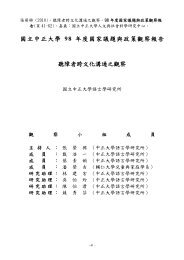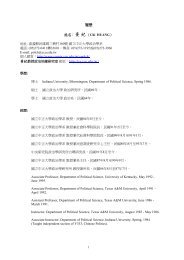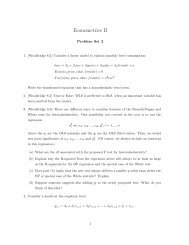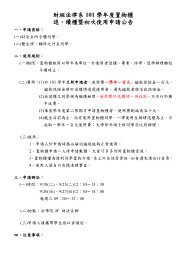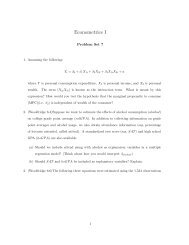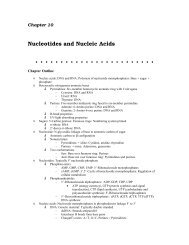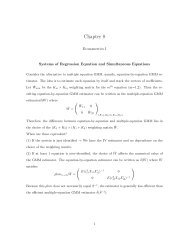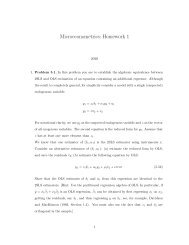Create successful ePaper yourself
Turn your PDF publications into a flip-book with our unique Google optimized e-Paper software.
Chapter 4<br />
<strong>Amino</strong> <strong>Acids</strong><br />
. . . . . . . . . . . . . . . . . . . . . . . .<br />
Chapter Outline<br />
v <strong>Amino</strong> acids: Tetrahedral alpha (α) carbon with H, amino group, carboxyl group, and side chain<br />
v <strong>Amino</strong> acids in proteins joined by peptide bonds<br />
v Classification<br />
Nonpolar: Ala, val, leu, ile, pro, met, phe, trp<br />
Polar uncharged: Gly, ser, thr, tyr, asn, gln , cys<br />
Acidic: Asp, glu<br />
Basic: His, lys, arg<br />
v Modified amino acids: Hydroxylysine, hydroxproline, thyroxin, methyl histidine, methyl<br />
arginine, methyl lysine, γ−carboxyglutamic acid, pyroglutamic acid, aminoadipic acid<br />
v Small molecules derived from amino acids: GABA, histamine, serotonin, β−alanine,<br />
epinephrine, penicillamine, ornithine, citrulline, betaine, homocysteine, homoserine<br />
v Ionic properties of amino acids<br />
α−Carboxyl group: pKa’s range from 2.0 to 2.4<br />
α−<strong>Amino</strong> group: pKa’s range from 9.0 to 9.8<br />
Side chains<br />
› Acidic pKa’s for asp, glu<br />
› Basic pKa’s for his, arg, lys<br />
v <strong>Amino</strong> acid chemistry<br />
Carboxyl chemistry<br />
<strong>Amino</strong> chemistry<br />
Side chain chemistry<br />
v Chirality: asymmetric carbon has four different groups attached<br />
Optically active compounds<br />
› Dextrorotatory (+), clockwise rotation<br />
› Levorotatory (-), counterclockwise rotation<br />
Asymmetric carbons<br />
› One asymmetric carbon: Mirror image isomers or enantiomers<br />
› More than one asymmetric carbon: enantiomers and diastereomers<br />
D,L System: Typically naturally occurring amino acids: L-amino acids; related to Lglyceraldehyde<br />
(R,S) System<br />
v Ultraviolet spectral properties of amino acids: Only phe, try, trp absorb UV light above 250 nm<br />
v Separation of amino acids<br />
Ion exchange<br />
› Anion exchangers: Matrix is positively charged so anions bind<br />
› Cation exchangers: Matrix is negatively charged so cations bind
Chapter 4 . <strong>Amino</strong> <strong>Acids</strong><br />
Chapter Objectives<br />
It is imperative to learn the structures and one letter codes for the amino acids. <strong>Amino</strong> acids<br />
are key molecules, both as components of proteins and as intermediates to important<br />
biomolecules. The structures are shown in Figure 4.3 of Biochemistry. Figure 4.3 is presented<br />
on the following two pages.<br />
Classification of <strong>Amino</strong> <strong>Acids</strong><br />
Here is an alternative classification scheme.<br />
Acidic amino acids and their amides:<br />
aspartic acid, asparagine, glutamic acid, glutamine.<br />
Basic amino acids:<br />
histidine, lysine, arginine.<br />
Aromatic amino acids:<br />
phenylalanine, tyrosine, tryptophan.<br />
Sulfur containing amino acids:<br />
cysteine, methionine.<br />
Imido acid:<br />
proline.<br />
Hydrophobic side chains:<br />
glycine, alanine, valine, leucine, isoleucine.<br />
Hydroxylic amino acids:<br />
serine, threonine, (tyrosine).<br />
To memorize the structures of the 20 amino acids, here are some aids:<br />
The side chain of glycine is H, that of alanine is a methyl group, CH3.<br />
The side chain of valine is just the methyl side chain of alanine with two methyl groups<br />
substituting for two Hs. (In effect it is just dimethylalanine.)<br />
The side chain of leucine is just valine with a -CH2- group between the valine side chain and the<br />
α carbon (or, leucine is alanine with the valine side chain attached).<br />
Isoleucine is an isomer of leucine with one of the methyl groups exchanged with a H on the<br />
carbon attached to the α carbon.<br />
Several of the amino acids have alanine as a base.<br />
Phenylalanine has a phenyl group (i.e., benzene ring) attached to alanine.<br />
Tyrosine is hydroxylated phenylalanine.<br />
Serine has a hydroxyl group substituting for a H on the methyl group of alanine.<br />
Cysteine can be thought of as the sulfur variety of serine i.e., with a sulfhydryl group in place of<br />
the hydroxyl group of serine.<br />
Threonine, a hydroxylic amino acid, can be thought of as methylated serine.<br />
The acidic amino acids and their amides are quite easy to remember. Aspartic acid and<br />
glutamic acid have carboxylic acid groups attached to -CH2- and (-CH2-)2, respectively. The<br />
amides of these amino acids, namely asparagine and glutamine, have ammonia attached to the<br />
side chain carboxyl groups in amide linkage.<br />
The basic amino acids all have six carbons, counting the carboxyl carbon and the α−carbon.<br />
Lysine's side chain is a linear chain of four -CH2- groups with a terminal amino group.<br />
Arginine has a linear side chain of three -CH2- groups to which a guanidinium group is<br />
attached. (The sixth carbon is the central C of the guanidinium group.) Guanidinium is like<br />
urea but with a nitrogen group replacing the carbonyl oxygen. Histidine has an imidazole ring<br />
attached to alanine. The ring contains two nitrogens and three carbons, a five-membered ring.<br />
An easy way to remember the structure of proline is to know that it derives from glutamic acid.<br />
The carboxyl side chain forms a C-N bond to the amino group to form this imido acid. (In the<br />
process, the carbon is reduced so the side chain carboxyl oxygens do not show up in proline.)<br />
44
Chapter 4 . <strong>Amino</strong> <strong>Acids</strong><br />
Methionine is a sulfur-containing amino acid. Biologically, it is also used as a methyl group<br />
donor in the molecule S-adenosylmethionine (SAM). These two facts indicate that the side chain<br />
ends in a S-CH3, which is attached to (-CH2-)2.<br />
The remaining amino acid is tryptophan. Its side chain is an indole ring attached to a -CH2-<br />
group. In effect it can be thought of as alanine with a indole ring. Substituted indole rings are<br />
widely used in biochemistry. The basic structure is a six-membered benzene ring fused to a<br />
five-membered ring containing a single N.<br />
Nomenclature<br />
The one letter codes for the amino acids must be memorized. In journals, the one letter<br />
codes are used to show amino acid sequences. See the answer to Problem 2 for a discussion of<br />
how the one letter codes are organized.<br />
Chirality<br />
The α−carbons of amino acids, excepting Gly, have four different groups attached to them,<br />
and hence they are chiral carbons. Two different arrangements of the four groups about the<br />
chiral carbon can be made, giving rise to two structural isomers. Structural isomers that are<br />
mirror images of each other are called enantiomers. When two or more chiral centers exist on a<br />
single molecule, 2 n structural isomers are possible, where n = the number of chiral centers. The<br />
various structural isomers include enantiomers (mirror-image-related isomers) and non mirrorimage-related<br />
isomers known as diastereomers.<br />
The structural isomers can be distinguished from each other using the R and S prefixes<br />
assigned to each chiral center of a molecule. The R and S prefixes are assigned according to a<br />
set of sequence rules. The four groups about a chiral center are assigned priority numbers with<br />
the highest priority given to the atom with the highest atomic number, thus S > O > N > C > H<br />
(for elements found in amino acids). When two or more groups have the same primary element,<br />
then elements attached to the primary element are considered. So for example, SH > OR > OH ><br />
NH2 > COOH > CHO > CH2OH > CH3. Once priority assignments are made, the molecule is<br />
viewed with the group having the lowest priority away from the reader. Moving from highest to<br />
lowest priority, for the three remaining groups, clockwise movement indicates R and<br />
counterclockwise indicates S configuration.<br />
UV-absorbing Properties<br />
Only three amino acids, phenylalanine, tyrosine, and tryptophan, absorb light in the near<br />
UV range (i.e., 230 nm to 310 nm). These amino acids will dominate the UV absorption spectra<br />
of proteins. The wavelength maxima for tyrosine and tryptophan are around 280 nm. In<br />
addition, these two amino acids have extinction coefficients quite a bit larger than the extinction<br />
coefficient of phenylalanine, whose λ max = 260 nm (See Figure 4.15). Thus very many proteins<br />
have maximum absorbance around 280 nm. In contrast, nucleic acids absorb light with a<br />
maximum around 260 nm due to the nucleotides. The extinction coefficients of the nucleotides<br />
are larger than those for the aromatic amino acids. In general, nucleic acid contamination of a<br />
protein sample will contribute to UV absorption at 260 nm. Often the 260/280 ratio is used as<br />
a criterion for purity.<br />
45
Chapter 4 . <strong>Amino</strong> <strong>Acids</strong><br />
Figure 4.3 The amino acids that are the building blocks of most proteins can be classified as (a)<br />
nonpolar (hydrophobic), (b) polar, neutral, (c) acidic, or (d) basic. Also shown are the one-letter<br />
and three-letter codes used to denote amino acids. For each amino acid, the ball-and-stick (left)<br />
and space-filling (right) models show only the side chain.<br />
46
Chapter 4 . <strong>Amino</strong> <strong>Acids</strong><br />
47
Chapter 4 . <strong>Amino</strong> <strong>Acids</strong><br />
48
Chapter 4 . <strong>Amino</strong> <strong>Acids</strong><br />
Problems and Solutions<br />
1. Without consulting chapter figures, draw Fisher projection formulas for glycine,<br />
aspartate, leucine, isoleucine, methionine, and threonine.<br />
Answer:<br />
Glycine<br />
+ H3N<br />
COO-<br />
C<br />
H<br />
H<br />
Aspartate<br />
COO-<br />
+ H3N C H<br />
CH 2<br />
COO-<br />
Leucine<br />
COO-<br />
+<br />
H3N C H<br />
CH 2<br />
CH<br />
H3C CH3 49<br />
Isoleucine<br />
COO-<br />
+<br />
H3N C H<br />
H 3C<br />
C<br />
H<br />
CH 2<br />
CH 3<br />
Methionine<br />
COO-<br />
+<br />
H3N C H<br />
CH 2<br />
CH 2<br />
S<br />
CH 3<br />
Threonine<br />
COO-<br />
+<br />
H3N C H<br />
2. Without reference to the text, give the one-letter and three-letter abbreviations for<br />
asparagine, arginine, cysteine, lysine, proline, tyrosine, and tryptophan.<br />
Answer: For many of the amino acids the l letter code is the first letter of the amino acid.<br />
Problems arise when two amino acids start with the same letter. Whenever this occurs, the<br />
amino acid with the lowest molecular weight is assigned the letter. The other amino acid is<br />
given a phonetic letter or the closest unused letter in the alphabet. The amino acids assigned<br />
their first letters are: Glycine, Alanine, Valine, Leucine, Isoleucine, Serine, Threonine, Proline,<br />
Cysteine, Methionine and Histidine. Aspartic acid is D, an easy way to remember it is to<br />
pronounce it as "asparDic" acid. Glutamic acid is E, E follows D, glutamic acid follows aspartic<br />
acid in chemical structure. E is also the closest unused letter to G. F is for phenylalanine,<br />
(Fenylalanine). R is for arginine, remembered by pronouncing arginine (Rginine). N is for<br />
asparagine; remember to stress the N sound. Glutamine follows asparagine, its l letter code is<br />
the next unused consonant after N, namely Q. Lysine is K, the closest unused letter to L.<br />
Tyrosine is Y; Y is the dominant sound in tyrosine. Tryptophan is W; remember "double ring,<br />
double you".<br />
3. Write equations for the ionic dissociations of alanine, glutamate, histidine, lysine,<br />
and phenylalanine.<br />
Answer: Alanine dissociation:<br />
COOH<br />
Glutamate Dissociation:<br />
+<br />
H3N C H<br />
COOH<br />
+ H3N C H<br />
CH 2<br />
CH 2<br />
COOH<br />
CH 3<br />
COO-<br />
+ H3N C H<br />
CH 2<br />
CH 2<br />
COOH<br />
COO-<br />
+<br />
H3N C H<br />
CH 3<br />
COO-<br />
+ H3N C H<br />
CH 2<br />
CH 2<br />
COO-<br />
NH 2<br />
COO-<br />
C<br />
H<br />
CH 3<br />
NH 2<br />
H<br />
COO-<br />
C<br />
H<br />
CH 2<br />
CH 2<br />
C<br />
COO-<br />
CH 3<br />
OH
Chapter 4 . <strong>Amino</strong> <strong>Acids</strong><br />
Histidine dissociation:<br />
COOH<br />
+ H3N C H<br />
+HN<br />
CH 2<br />
NH<br />
Lysine dissociation:<br />
COOH<br />
+ H3N C<br />
CH 2<br />
CH 2<br />
CH 2<br />
H<br />
CH2 + H3N<br />
Phenylalanine dissociation:<br />
COOH<br />
+H 3N C H<br />
CH 2<br />
+ H3N C H<br />
+HN<br />
+ H3N C<br />
CH 2<br />
CH 2<br />
CH 2<br />
CH 2<br />
+ H3N<br />
COO-<br />
CH 2<br />
NH<br />
COO-<br />
50<br />
+ H3N C H<br />
N<br />
H H 2N C<br />
COO-<br />
+H 3N C H<br />
CH 2<br />
CH 2<br />
CH 2<br />
CH 2<br />
CH 2<br />
+ H3N<br />
COO-<br />
CH 2<br />
NH<br />
COO-<br />
H<br />
H 2N C H<br />
N<br />
H 2N C<br />
COO-<br />
H 2N C H<br />
CH 2<br />
COO-<br />
CH 2<br />
CH 2<br />
CH 2<br />
CH 2<br />
CH 2<br />
NH 2<br />
NH<br />
COO-<br />
4. How is the pKa of the a-NH3 + group affected by the presence on an amino acid of the<br />
a-COOH?<br />
Answer: The pKa on an isolated amino group is around 10 (as for example, the side chain amino<br />
group of lysine whose pKa = 10.5 (see Table 4.1). In general, the pKas of α amino groups in the<br />
amino acids are around 9.5. Thus, the proximity of the α carboxyl group lowers the pKa of the<br />
α amino group.<br />
5. Draw an appropriate titration curve for aspartic acid, labeling the axis and<br />
indicating the equivalence points and the pKa values.<br />
Answer: For a titration curve the independent variable is the amount of acid or base used to<br />
titrate the amino acid. The dependent variable is pH.<br />
H
Chapter 4 . <strong>Amino</strong> <strong>Acids</strong><br />
The equivalence point is a point on the titration curve reached after a molar equivalent of acid or<br />
base is added to the amino acid. For aspartic acid there are actually three equivalence points at<br />
around 3.0, 6.2 and 12.2.<br />
6. Calculate the concentrations of all ionic species in a 0.25 M solution of histidine at<br />
pH 2, pH 6.4, and pH 9.3.<br />
Answer: The pKas for histidine are 1.8, 6.0, and 9.2. At pH 2.0, we can ignore the two higher<br />
pKas. At this pH, histidine's side chain and the α-amino group are protonated and thus both are<br />
positively charged. So, the ionic species of histidine at pH = 2.0 depend critically on the<br />
ionization state of the carboxyl group. When the carboxyl group is in the carboxylate form,<br />
histidine will be in the 1+ ionic form. When the carboxyl group is protonated, and hence<br />
uncharged, histidine will carry a 2+ charge. For the α-carboxyl group:<br />
pH = pK a + log [COO − ]<br />
[COOH] or,<br />
[COO − ]<br />
[COOH] = 10pH− pK a = 10 2.0−1.8 = 1.58 or [COO − ] =1.58 ×[COOH] and,<br />
[COO − ] +[COOH] = 0.25M<br />
Thus, 1.58 ×[COOH] +[COOH] = 2.58[COOH] = 0.25M and,<br />
[COOH] = .25M<br />
2.58<br />
= 0.097M and,<br />
[COO − ] = 1.58 ×[COOH] = 0.153M<br />
So, at pH = 2.0, [His 2+ ] = 0.097M and [His 1+ ] = 0.153M<br />
The concentration of uncharged histidine and negatively charged histidine are both small but<br />
can be estimated as follows. The concentration of uncharged histidine will be approximately<br />
equal to the concentration of the unprotonated side-chain species. Using the Henderson-<br />
Hasselbalch equation with pKa = 6.0, pH = 2.0, and [His 1+] = 0.153 M, we find that<br />
51
Chapter 4 . <strong>Amino</strong> <strong>Acids</strong><br />
pH = 6.0 + log [His 0 ]<br />
[His 1+ ]<br />
52<br />
or,<br />
[His 0 ]<br />
[His 1+ = 10<br />
]<br />
pH − 6.0 = 10 2.0− 6.0 and,<br />
[His 0 ] = [His 1+ ] × 10 −4 = 1.53 × 10 −5 M<br />
The concentration of negatively charged histidine is calculated using the Henderson-Hasselbalch<br />
equation with pKa = 9.2, pH = 2.0, and [His 0] = 1.53 x 10 -5 M. In this case<br />
pH = 9.2 + log [His1- ]<br />
[His 1- ]<br />
[His 0 ]<br />
[His 0 ]<br />
or,<br />
= 10 pH− 9.2 = 10 2.0−9.2 and,<br />
[His 1- ] = [His 0 ] ×10 −7.2 = 1.53 ×10 −5 ×10 −7.2 = 9.6 ×10 −13 M<br />
At pH = 2.0 we have: [His 2+] = 0.097 M , [His 0] = 1.53 x 10 -5 M,<br />
[His 1+] = 0.153 M, [His 1-] = 9.6 x 10 -13 M.<br />
At pH = 6.4, we can assume that the carboxyl group is fully unprotonated and carries a -1<br />
charge while the α-amino group is fully protonated and carries a +1 charge. Thus, the ionic<br />
species of histidine depends critically on the ionic state of the imidazole side chain. When the<br />
imidazole group is protonated, histidine carries a net +1 charge. When it is unprotonated,<br />
histidine is uncharged.<br />
So, using<br />
pH = 6.0 + log [His 0 ]<br />
[His 1+ ]<br />
and [His 0 ] + [His 1+ ] = 0.25M ,<br />
we find that the ionic species of histidine at pH = 6.4 are :<br />
[His 0 ] = 0.179M and [His 1+ ] = 0.071M<br />
[His 2+] and [His 1-] are calculated using the Henderson-Hasselbalch equation with pH = 6.4, pKa<br />
= 1.8 and 9.2 and [His 1+] = 0.071 M and [His 0] = 0.179 M. We find [His 2+] = 2.8 x 10 -6 M and<br />
[His 1-] = 2.25 x 10 -4 M.<br />
At pH = 6.4 we have: [His 2+] = 1.78 x 10 -6 M , [His 0] = 0.179 M,<br />
[His 1+] = 0.071 M, [His 1-] = 2.84 x 10 -4 M.<br />
At pH = 9.3, the carboxyl group is unprotonated and negatively charged, the imidazole group is<br />
unprotonated and uncharged, and only the protonation state of the α-amino group needs to be<br />
determined. Histidine, at pH = 9.3 will be portioned between the His 0 and His 1- states. From<br />
pH = 9.2 + log [His1- ]<br />
[His 0 ]<br />
and [His 0 ] + [His 1- ] = 0.25M ,<br />
we find that the ionic species of histidine at pH = 9.3 are :<br />
[His 0 ] = 0.111M, [His 1- ] = 0.139M and<br />
[His 2+ ] = 1.75 ×10 -12 M, [His + ] = 5.5 ×10 -5 M<br />
7. Calculate the pH at which the g carboxyl group of glutamic acid is two-thirds<br />
dissociated.<br />
Answer: The pKa of γ carboxyl group of glutamic acid is 4.3.
Chapter 4 . <strong>Amino</strong> <strong>Acids</strong><br />
Using the Henderson - Hasselbalch equation<br />
pH = pK COOH + log [C γ OO− ]<br />
[C γ OOH]<br />
When the γ - carboxyl group is two - thirds dissociated :<br />
[C γOO − ]<br />
[CγOO − =<br />
] +[C γOOH]<br />
2<br />
3 or, [C γOO − ] = 2<br />
3 [C γOO − ⎛ ] +[C ⎞<br />
⎝<br />
γOOH]<br />
⎠<br />
Thus, [C γOOH] = 1<br />
2 [C γOO − ]<br />
Upon substituting into the Henderson-Hasselbalch equation we find :<br />
pH = 4.3 + log [C γOO − ]<br />
[Cγ OOH] = 4.3 + log [C γOO − ]<br />
1<br />
2 [C γOO − ]<br />
pH = 4.6<br />
53<br />
= 4.3 + log 2<br />
8. Calculate the pH at which the e-amino group of lysine is 20% dissociated.<br />
Answer: For the lysine side chain, pKa = 10.5.<br />
Using the Henderson - Hasselbalch equation<br />
pH = pK +<br />
NεH + log<br />
3<br />
[N εH2] +<br />
[N εH3 ]<br />
When the ε - amino group is 20% d issociated:<br />
[N εH2] = .2 (20%) or, [N<br />
+ εH2] = .2 ⎛<br />
+<br />
[N εH2] +[N εH3 ] ⎞<br />
⎝<br />
⎠<br />
[N εH2 ] +[N εH3] Thus, [N εH2] = 1<br />
4 [N +<br />
εH3 ]<br />
Upon substituting into the Henderson-Hasselbalch equation we find :<br />
pH = 10.5 + log [N 1<br />
εH2 ]<br />
=10.5 + log<br />
4<br />
+<br />
[N εH3 ]<br />
[N +<br />
εH3 ]<br />
+<br />
[N εH3 ]<br />
pH = 9.9<br />
= 10.5 − log 4<br />
9. Calculate the pH of a 0.3 M solution of (a) leucine hydrochloride, (b) sodium leucinate,<br />
and (c) isoelectric leucine.<br />
Answer: The solution 0.3 M leucine HCl is composed of 0.3 M leucine and 0.3 M HCl. Thus, we<br />
expect it to have an acidic pH and only the α carboxyl group of leucine is involved in proton<br />
equilibrium.<br />
The pKa of the α carboxyl of leucine is 2.4. Thus,<br />
pH = pKa + log [ A − ]<br />
[HA] = 2.4 + log [COO− ]<br />
[COOH]<br />
[COO − ] + [COOH ] = 0.3M (2)<br />
For charge neutrality :<br />
[Cl - ] + [COO - ] = [H + ] + [NH 3 + ]<br />
(1) and,
Chapter 4 . <strong>Amino</strong> <strong>Acids</strong><br />
If we recognize that [Cl - ] =[NH 3 + ] (because Cl - and the amino acid are in equimolar amounts),<br />
the charge neutrality equation may be simplified to:<br />
[COO - ] =[H + ] and combined with (1) and (2) we have :<br />
[H<br />
pH = 2.4 + log<br />
+ ]<br />
0.3−[H + ]<br />
If we make the assum ption that [H + ]
Chapter 4 . <strong>Amino</strong> <strong>Acids</strong><br />
At the pI, [ COO − ] = [NH 3 + ]<br />
Using the Henderson - Hasselbalch equations<br />
pH = pKCOOH + log [COO− ]<br />
[COOH] and pH = pK + + log<br />
NH 3<br />
[NH2] +<br />
[NH 3 ]<br />
and recognizing that [COOH] = [<strong>Amino</strong> acid] total -[COO − ]<br />
and that [NH 2] = [<strong>Amino</strong> acid] total -[NH 3 + ]<br />
upon substituting, solving for [ COO − +<br />
] and [NH 3],<br />
and setting these terms<br />
equal at pH = pI we find that<br />
pI = pKCOOH + pK +<br />
NH 3<br />
2<br />
2.4 + 9.6<br />
pI = = 6.0<br />
2<br />
or<br />
10. Quantitative measurements of optical activity are usually expressed in terms of the<br />
specific rotation, [a]D 25, defined as<br />
[ α ] D 25 = Measured rotation in degrees × 100<br />
(Optical path in dm) ×(conc. in g/ml)<br />
For any measurement of optical rotation, the wavelength of the light used and the<br />
temperature must both be specified. In this case, D refers to the "D line" of sodium at<br />
589 nm and 25 refers to a measurement temperature of 25°C. Calculate the<br />
concentration of a solution of L-arginine that rotates the incident light by 0.35° in an<br />
optical path length of 1 dm (decimeter).<br />
Answer:<br />
[α ] D 25 = Measured rotation in degrees × 100<br />
(Optical path in dm) ×(conc. in g/ml)<br />
[Arg] = 0.35°×100<br />
[α ] D 25 × 1dm<br />
[α ] D 25 for L-arginine = 12.5° (from Table 4.2)<br />
Thus, [Arg] = 0.35°×100<br />
= 2.8 g/ml<br />
12.5°× 1dm<br />
11. Absolute configurations of the amino acids are referenced to D- and Lglyceraldehyde<br />
on the basis of chemical transformations that can convert the molecule<br />
of interest to either of these reference isomeric structures. In such reactions, the<br />
stereochemical consequences for the asymmetric centers must be understood for each<br />
reaction step. Propose a sequence of reactions that would demonstrate that L(-)-serine is<br />
stereochemically related to L(-)-glyceraldehyde.<br />
Answer: The aldehyde group of L(-)-glyceraldehyde is converted to L-glyceric acid by oxidation<br />
and L-glyceric acid is converted to 2-hydroxypropanoic acid. 2-Hydroxypropanoic acid is<br />
converted to 2-bromopropanoic acid by nucleophilic substitution using concentrated HBr. The<br />
reaction results in alteration in stereochemistry. 2-Bromopropanoic acid is subsequently<br />
converted to L-(-)-alanine by ammonolysis and alteration in stereochemistry. Finally, L-(-)alanine<br />
is convert serine. The reaction sequence is shown below.<br />
55
Chapter 4 . <strong>Amino</strong> <strong>Acids</strong><br />
L-(-)-Glyceraldehyde L-Glyceric acid 2-Hydroxypropanoic acid<br />
CHO<br />
HO C H<br />
CH2OH<br />
COOH<br />
H C Br<br />
CH3<br />
COOH<br />
HO C H<br />
CH2OH<br />
COOH<br />
H2N C H<br />
CH3<br />
56<br />
COOH<br />
HO C H<br />
CH3<br />
COOH<br />
H2N C H<br />
CH2OH<br />
2-Bromopropanoic acid L-(-)-Alanine L-(-)-Serine<br />
12. Describe the stereochemical aspects of the structure of cystine, the structure that is<br />
a disulfide-linked pair of cysteines.<br />
Answer: Cystine (dicysteine) has two chiral carbons, the two a-carbons of the cysteine moieties.<br />
Since each chiral center can exist in two forms there are 4 stereoisomers of cystine. However, it<br />
is not possible to distinguish the difference between L-cysteine/D-cysteine and D-cysteine/Lcysteine<br />
dimers. So three distinct isomers are formed.<br />
H<br />
H<br />
H<br />
H<br />
-OOC<br />
+H 3N<br />
C<br />
CH 2<br />
S<br />
S<br />
CH2 C COO-<br />
H<br />
NH 3+<br />
L-cysteine-<br />
L-cysteine<br />
+H 3N<br />
+H 3N<br />
C<br />
CH 2<br />
S<br />
S<br />
CH2 C COO-<br />
H<br />
COO-<br />
L-cysteine-<br />
D-cysteine<br />
-OOC<br />
-OOC<br />
C<br />
CH 2<br />
S<br />
S<br />
CH2 C NH3+ H<br />
NH 3+<br />
D-cysteine-<br />
L-cysteine<br />
+H 3N<br />
-OOC<br />
C<br />
CH 2<br />
S<br />
S<br />
CH 2<br />
C NH3+ H<br />
COO-<br />
D-cysteine-<br />
D-cysteine<br />
13. Draw a simple mechanism for the reaction of a cysteine sulfhydryl group with<br />
iodoacetamide.<br />
Answer:<br />
+H 3N<br />
I CH2 C NH2 S-<br />
CH2 C COO-<br />
H<br />
O<br />
I -<br />
+H 3N<br />
NH2 C O<br />
CH 2<br />
S<br />
CH2 C COO-<br />
14. Describe the expected elution pattern for a mixture of aspartate, histidine,<br />
isoleucine, valine, and arginine on a column of Dowex-50.<br />
H
Chapter 4 . <strong>Amino</strong> <strong>Acids</strong><br />
Answer: Dowex is an anion exchanger with a positive charge due to a quaternary amine. Thus,<br />
one expects amino acids to elute from Dowex in the following order: basic (positively-charged)<br />
amino acids; neutral (uncharged amino acids); acidic (negatively-charged amino acids).<br />
We expect arginine to elute first followed by histidine. Of these two basic amino acids, arginine<br />
will have a +1 charge at neutral pH whereas histidine’s charge will slightly less that +1.<br />
Next we expect isoleucine followed by valine. The charge on these amino acids will be close to<br />
(but not) zero; however, isoleucine will be slightly less negatively charged than valine. (The<br />
isoelectric point, the pH at which a molecule has a net charge of zero, is simply the average<br />
value of the pKas (for amino acids lacking ionizable R groups). Thus, isoleucine’s isoelectric<br />
point is (2.4 + 9.7)/2 = 6.05 whereas valine’s isoelectric point is (2.3 + 9.6)/2 = 5.95. At neutral<br />
pH we expect isoleucine to be slightly less negatively charged than valine.)<br />
Finally, we expect aspartate to elute last because it is an acidic, negatively-charged amino acid.<br />
15. Assign (R,S) nomenclature to the threonine isomers of Figure 4.14.<br />
Answer:<br />
+H 3N<br />
H<br />
57<br />
COO-<br />
The groups about the α-carbon of L-threonine are assigned the following priority: NH3 + > COO- ><br />
Cβ> H. In Fischer projections, two groups joined to the α-carbon (i.e., NH3 + and H) are coming<br />
out of the plane while the other two groups are into the plane. By rotating the molecule such<br />
that the group with the lowest priority, namely H, is away from the reader, the NH3 + group will<br />
be located on the right side of the α-carbon, the carboxyl group above and to the left, and the<br />
remaining β-carbon to the left and below the α-carbon:<br />
3<br />
C<br />
C<br />
H<br />
CH 3<br />
2<br />
OH<br />
COO - H<br />
C C C α NH +<br />
β 3<br />
Since moving from highest to lowest priority involves counterclockwise movement the α-carbon<br />
is in the S configuration.<br />
For the β-carbon, the priority is OH > Cα > CH3 > H. The orientation of the Cα-Cβ bond was<br />
already defined for the α-carbon as being into the plane therefore it must be out of the plane for<br />
the β-carbon, as must be the bond to -CH3. Thus, bonds to OH and H are into the plane. By<br />
rotating the molecule such that H is behind the β-carbon, we find the OH to the left, CH3 below<br />
and Cα above:<br />
HO<br />
1<br />
Cα<br />
C<br />
β<br />
Since moving from highest to lowest priority involves clockwise movement the α-carbon is in the<br />
R configuration. The β-carbon is in the R configuration.<br />
2<br />
1<br />
H<br />
CH3<br />
3
Chapter 4 . <strong>Amino</strong> <strong>Acids</strong><br />
+H 3N<br />
H<br />
COO-<br />
C<br />
C<br />
H<br />
CH 3<br />
OH<br />
H<br />
HO<br />
COO-<br />
C<br />
C<br />
CH 3<br />
NH 3+<br />
H<br />
58<br />
+H 3N<br />
COO-<br />
C<br />
C<br />
CH 3<br />
H<br />
H<br />
H<br />
COO-<br />
C<br />
C<br />
CH 3<br />
NH 3+<br />
L-Threonine D-Threonine L-Allothreonine D-Allothreonine<br />
By inspection we see that<br />
L-threonine is (2S, 3R) threonine<br />
D-threonine is (2R,3S) threonine<br />
L-allothreonine is (2S,3S) threonine<br />
D-allothreonine is (2R,3R) threonine<br />
Questions for Self Study<br />
1. Fill in the blanks: A bond is an amide bond between two . The bond is formed by a<br />
reaction between the of one amino acid and the of a second amino acid with the<br />
elimination of the elements of . The result is a linear chain with an end and a end.<br />
The chain can be extended into a polymer with additional amino acids. The polymer formed is<br />
called either a or a depending on the number of amino acids joined. The amide bond<br />
can be broken by the addition of the elements of water across it in a reaction.<br />
2. List the four classes of amino acids.<br />
3. Indicate which class of amino acids best represents the statements presented below:<br />
a. Their side chain may contain a hydroxyl group. .<br />
b. Negatively charged at basic pH. .<br />
c. Relatively poorly soluble in aqueous solution. .<br />
d. Relatively soluble in aqueous solution. .<br />
e. Positively charged at acidic pH. .<br />
f. Side chains are capable of hydrogen bonding. .<br />
g. Includes the amino acids arginine, histidine and lysine. .<br />
h. Side chains contain predominantly hydrocarbons._____<br />
i. Side chains are responsible for the hydrophobic cores of globular proteins. .<br />
j. The amides of glutamic and aspartic acid belong to this group. .<br />
4. From the list of amino acids presented indicate which one best fits the description:<br />
a. The smallest amino acid (It also lacks a stereoisomer).<br />
alanine, glycine, phenylalanine, glutamine<br />
b. An aromatic amino acid.<br />
glutamic acid, tyrosine, isoleucine, proline<br />
c. A sulfur-containing amino acid.<br />
methionine, aspartic acid, arginine, leucine<br />
d. An amino acid capable of forming sulfur-sulfur bonds.<br />
methionine, proline, cysteine, tryptophan<br />
e. A branched chain amino acid.<br />
methionine, leucine, aspartic acid, asparagine<br />
5. Fill in the blanks. Most of the amino acids are chiral compounds because they have at least<br />
one carbon atom with different groups attached. Thus, there are ways of arranging the<br />
four groups about the carbon atom. For the case of an amino acid with a single asymmetric<br />
carbon, the isomers pairs that can be formed are called ; they are nonsuperimposable, .<br />
images of each other. Using the D,L system of nomenclature, the commonly occurring amino<br />
acids are all amino acids.<br />
6. Which three amino acids absorb light in the ultraviolet region of the spectrum above 250<br />
nm?<br />
HO<br />
H<br />
OH
Chapter 4 . <strong>Amino</strong> <strong>Acids</strong><br />
7. Of the following techniques which are commonly used to separate amino acids: ion<br />
exchange, NMR, electroporation, HPLC, UV spectroscopy, ninhydrin reaction?<br />
8. DTNB (Ellman's reagent), iodoacetate, and N-ethylmaleimide are three agents that are used to<br />
modify which amino acid? What is the reactive group on the amino acid with which all three<br />
agents react?<br />
9. Although there are twenty common amino acids, there are hundreds of different amino acids<br />
found in nature, some of which derive from the common amino acids by simple chemical<br />
(biochemical) modification. Name one common modification of amino acids found in nature.<br />
10a. Of the twenty common amino acids which amino acid has a pKa around neutrality?<br />
b. What amino acid lacks an amino group?<br />
Answers<br />
1. peptide; amino acids; amino group; carboxyl group; water; N-terminal (or amino ); Cterminal<br />
(or carboxyl); polypeptide; protein; hydrolysis.<br />
2. Nonpolar or hydrophobic; neutral polar; acidic; basic.<br />
3. a./neutral polar; b./acidic; c./nonpolar; d./neutral polar, acidic, and basic; e./basic;<br />
f./neutral polar, acidic, and basic; g./basic; h./nonpolar; i./nonpolar; j./neutral polar.<br />
4. a. glycine; b. tyrosine; c. methionine; d. cysteine; e. leucine.<br />
5. Four; two; enantiomers (or mirror image isomers); mirror; L.<br />
6. Phenylalanine, tyrosine, and tryptophan.<br />
7. ion exchange, HPLC<br />
8. cysteine; sulfhydryl group.<br />
9. Hydroxylation, methylation, carboxylation, phosphorylation.<br />
10. a./Histidine; b./proline.<br />
Additional Problems<br />
1. Sketch the titration curve of histidine.<br />
2. In the protein hemoglobin, a number of salt bridges (ionic bonds) are broken in going from<br />
oxygenated to deoxygenated hemoglobin. One in particular involves an aspartic acid: histidine<br />
ionic interaction. (a). At pH = 7.0, would you expect this salt bridge to form? Explain. (b).<br />
Under certain conditions (low oxygen tension) the salt bridge does form. Explain how the<br />
influence of aspartic acid on histidine is similar to the influence of the α carboxyl group on the<br />
pKa of the α amino group (and vice versa).<br />
3. How might the presence of calcium ions affect the apparent pKas of the side chains of aspartic<br />
acid and glutamic acid?<br />
4a. The ultraviolet spectra of proteins are largely determined by what three amino acids?<br />
b. In working with nucleic acids it is often useful to measure the optical densities at 260 nm<br />
and 280 nm. Nucleic acids (DNA and RNA) absorb more strongly at 260 nm than 280 nm such<br />
that the ratio A260 : A280 ranges from 1.6 to 2.0. What might happen to the A260 : A280 ratio of a<br />
solution of nucleic acid contaminated with protein?<br />
59
Chapter 4 . <strong>Amino</strong> <strong>Acids</strong><br />
c. Proteins typically have a A260 : A280 ratio less than one. Using Figure 4.15, estimate the A260 :<br />
A280 ratio of a protein whose amino acid composition includes two moles of Trp and one mole of<br />
Tyr per mole of protein.<br />
d. Certain proteins lack both Trp and Tyr yet still absorb ultraviolet light in the range of 240 nm<br />
to 270 nm. What amino acid is responsible for this? How would the A260 : A280 ratio of a<br />
protein rich in this amino acid differ from a typical protein containing Trp and Tyr?<br />
5. Poetry comes in many forms. Can you write a short, two line poem, using the single-letter<br />
abbreviations for the amino acids?<br />
Abbreviated Answers<br />
1. Histidine is the only amino acid with a pKa around neutrality. The pKas of histidine are 1.8,<br />
6.0, and 9.2. The titration curve will be similar to the one shown in the answer to problem 5<br />
but with an additional plateau around pH = 6.0.<br />
2. (a) The pKas of the side chains of aspartic acid and histidine are 3.9 and 6.0 respectively. At<br />
pH = 7.0, the side chain of aspartic acid is unprotonated and therefore negatively charged,<br />
whereas the side chain of histidine is also unprotonated and therefore uncharged. We might not<br />
expect this interaction to occur.<br />
(b) The fact that the salt bridge forms indicates that the two amino acid side chains are close<br />
together in the three dimensional structure of the protein. The proximity of the negatively<br />
charged aspartic acid must therefore raise the pKa of the histidine side group.<br />
3. Calcium (Ca 2+) may bind to carboxylate ions. Therefore, the presence of calcium may lower<br />
the apparent pKas of aspartic acid and glutamic acid.<br />
4. a./Phe, Tyr, and Trp.; b./ A260 : A280 ratio may be lower.<br />
c./The molar absorptivity for Trp at 280 nm and 260 nm are approximately 4,000 and 3,000<br />
respectively. The molar absorptivity for Tyr at 280 nm and 260 nm are approximately 1,000 and<br />
500 respectively. The A260 : A280 ratio is given by:<br />
(2 × 3,000) + 500<br />
Ratio = = 0.72<br />
(2 × 4,000) +1, 000<br />
d./Phe. The A260 : A280 ratio would be much greater that 1.<br />
5. Here is a start that is by no means original. "I think that I shall never see a ...." Try<br />
composing one with the nucleoside one-letter code (A,T,G and C) if you really want a challenge.<br />
60
Chapter 4 . <strong>Amino</strong> <strong>Acids</strong><br />
Summary<br />
<strong>Amino</strong> acids are the building blocks of proteins. There are 20 amino acids commonly found<br />
in proteins. The general structure of an amino acid is based on a central α-carbon, to which is<br />
attached a carboxyl group, a hydrogen, an amino group, and a variable side chain or R group.<br />
<strong>Amino</strong> acids can be classified according to the nature of their R groups into three classes. The<br />
nonpolar, hydrophobic amino acids include alanine, valine, leucine and isoleucine in addition<br />
to proline, methionine, phenylalanine and tryptophan. Polar, uncharged amino acids<br />
include glycine, serine, threonine, tyrosine, asparagine, glutamine, and cysteine. The<br />
acidic amino acids are aspartic acid and glutamic acid and the basic amino acids include<br />
histidine, lysine, and arginine. The amino acids are weak polyprotic acids. The carboxyl<br />
group is a rather strong carboxylic acid with pKa around 2.0, whereas the amino group is a base<br />
with pKa around 9.5. At neutral pH, the carboxyl group is unprotonated and negatively charged<br />
whereas the amino group is protonated and positively charged. Considering only these two<br />
groups at pH = 7.0, amino acids are zwitterionic. Several of the side chains have titratable<br />
groups including aspartic acid, glutamic acid, cysteine, tyrosine, arginine, histidine, and lysine.<br />
In proteins, amino acids are joined by peptide (or amide) bonds. The carboxyl group of one<br />
amino acid is joined to the amino group of another amino acid, with elimination of the elements<br />
of water.<br />
In addition to the twenty common amino acids, there are a large number of modified amino<br />
acids found in nature. Examples include hydroxylation of lysine and proline, methylation of<br />
lysine, carboxylation of glutamic acid, phosphorylation of serine, threonine and tyrosine.<br />
Metabolites derived from amino acids play key roles in cells. Knowing the structures of<br />
ornithine, citrulline, aspartic acid and arginine will serve as a strong basis for understanding the<br />
urea cycle. Transamination of glutamic acid and aspartic acid produce α-ketoglutarate and<br />
oxaloacetate, respectively, two citric acid cycle intermediates. The same reaction with alanine<br />
produces pyruvate. A great many small molecules acting as neurotransmitters, hormones,<br />
antibiotics, and other roles are directly derived from amino acids.<br />
The amino acids can participate in a number of useful chemical reactions, some specific to<br />
either the carboxyl group or the amino group common to all amino acids. Other chemistries are<br />
specific for side groups. For example, the sulfhydryl group of cysteine can be modified with Nethylmaleimide<br />
or iodoacetate. It will react with DTNB in a reaction producing a colored<br />
compound, which can be readily quantitated. The amino group of lysine, hydroxyl groups of<br />
serine, tyrosine and threonine and the carboxyl groups of aspartic and glutamic acid can<br />
participate in specific reactions.<br />
The α-carbons of all of the amino acids except glycine are chiral. Thus amino acids can exist<br />
as stereoisomers. In nature, the L amino acids predominate. We will consider stereochemistry<br />
again when sugar structures are discussed.<br />
There are two general methods for separating and analyzing amino acid mixtures. In one<br />
method, the ionic properties of the amino acids are exploited in ion exchange. Ion exchange<br />
involves a stationary charged species in equilibrium with a counter ion. Conditions are<br />
established such that the amino acids can displace the counter ion and bind to the stationary<br />
phase. The degree to which amino acids bind to the stationary phase depends on their intrinsic<br />
charge and on the concentration of counter ion with which they compete. Removal of amino<br />
acids from the stationary phase can be accomplished either by changing the pH of the solution<br />
(and thus changing the charge on the amino acids) or increasing the concentration of counter<br />
ion. The conditions under which a particular amino acid is displaced from the stationary phase<br />
are characteristic of the amino acid.<br />
The other technique for separating amino acids is to react the amino terminus with a<br />
hydrophobic group and to separate the derivatized amino acids by reverse phase<br />
chromatography. In reverse phase chromatography, derivatized amino acids are bound to a<br />
stationary, hydrophobic phase and subsequently eluted with increasing concentrations of a<br />
polar substance (e.g., methanol).<br />
61




